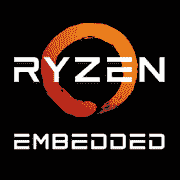AMD Ryzen Embedded V2546

AMD Ryzen Embedded V2546: Compact Power for Specialized Solutions
April 2025
Introduction
The AMD Ryzen Embedded processors have long been recognized as reliable solutions for industrial systems, media centers, and compact PCs. The V2546 model, released in 2023, combines energy efficiency with performance, remaining relevant in 2025. Let's explore who this chip is suitable for and how to correctly integrate it into a system.
Key Features: Renoir Architecture and More
7 nm and Zen 2: Technological Foundation
The processor is built on the Zen 2 architecture using TSMC's 7nm process. Although Zen 3 and Zen 4 have already taken the market by storm, Zen 2 remains relevant thanks to optimizations for embedded solutions.
- 6 cores / 12 threads: A balance between multithreading and thermal output.
- Base clock 3.0 GHz, maximum — 3.95 GHz: Suitable for tasks with moderate load.
- Integrated graphics Radeon Graphics 384SP: Based on the Vega architecture, supports 4K@60Hz.
Key Features:
- TDP 35W: Ideal for passive cooling.
- ECC memory support: Critical for industrial systems.
- Hardware virtualization (AMD-V): Useful for servers and virtual machines.
Performance:
- Geekbench 6: 1263 (Single-Core), 4976 (Multi-Core). For comparison, the Intel Core i5-1240P (15W) shows ~1400/5500, but is more expensive (~$450).
Compatible Motherboards: Socket FP6 and Chipsets
Important: The Ryzen Embedded V2546 uses the FP6 socket (BGA version), meaning it integrates directly onto the board with no option for replacement. This is typical for embedded solutions.
Recommended Boards:
- ASRock Industrial IMB-V2546: Compact (Mini-ITX), 2x DDR4 slots, 4x USB 3.2, 2x 10 GbE. Price: ~$250.
- Supermicro M11SDV-8C-LN4F: ECC support, 4x LAN, PCIe 3.0 x8. Price: ~$300.
Chipsets:
- AMD FP6 Platform: Specialized platform with support for USB4, PCIe 3.0, SATA III.
Tip: Choose boards with passive cooling and an extended temperature range (-40°C to +85°C) if the system will operate in extreme conditions.
Memory: DDR4 with and without ECC
The processor supports DDR4-3200 in dual-channel mode. The maximum capacity is 64GB (2x32GB).
- ECC memory: Recommended for NAS, medical equipment.
- Low-voltage modules (1.2V): Reduce power consumption.
Example Configuration:
- 2x16GB Kingston ValueRAM DDR4-3200 ECC (~$120 for the kit).
Power Supply: Minimum Watts — Maximum Efficiency
The processor itself consumes up to 35W, but the total system power depends on peripherals:
- SSD/HDD: +5-10W.
- Network interfaces (10 GbE): +3-7W per port.
Recommendations:
- For a basic system (processor + 2 SSDs + 2x RAM): A PSU in the 150-200W range (e.g., Seasonic SSP-200SU, ~$60).
- For industrial solutions with redundancy: A PSU with 80 Plus Platinum and hot-swappable capability (e.g., Delta Electronics EPS-300AB, ~$130).
Pros and Cons: Who is V2546 the Sweet Spot For?
Pros:
1. Energy efficiency: 35W TDP with desktop-level CPU performance.
2. Integrated graphics: Support for 4K and hardware decoding for H.265.
3. Long support duration: AMD guarantees — 10 years.
Cons:
1. No upgradeability: BGA socket prevents CPU changes.
2. Limited multithreading: 6 cores lag behind 8-core competitors in rendering.
3. Price: ~$350 for the CPU — more expensive than similar Intel N100 (~$120), but offers higher performance.
Usage Scenarios: Where Will V2546 Shine?
1. Industrial PCs: Machine control, data collection from sensors.
Example: A quality control system in a factory using AI-driven image analysis based on V2546.
2. Media Centers: 4K HDR, streaming.
Example: A mini-PC with V2546 replaces an Apple TV, supporting Plex and Twitch streaming.
3. Network Attached Storage (NAS): ECC and virtualization support.
Example: A Synology DS620 with a V2546 equivalent processes 10+ Docker containers.
4. Thin Clients: Office tasks, cloud applications.
Not Suitable For:
- AAA gaming (integrated graphics are weaker than NVIDIA GTX 1650).
- Heavy 3D modeling.
Comparison with Competitors
1. Intel Core i5-1245U (15W, 10 cores, 12 threads)
- Pros: Higher Single-Core performance (1350 in Geekbench 6), Thunderbolt 4.
- Cons: 15W TDP leads to throttling under load. Price: ~$400.
2. AMD Ryzen 5 5500U (15W, 6 cores)
- Pros: Cheaper (~$250), similar performance.
- Cons: No ECC support, shorter warranty.
3. Qualcomm QCS6490 (ARM, 8 cores)
- Pros: Energy efficiency (5W), 5G modem.
- Cons: Weak x86 compatibility.
Conclusion: The V2546 excels in the embedded systems niche where stability and long-term support are necessary.
Assembly Tips
1. Cooling: Even at 35W, use a heat sink with heat pipes in a closed case (e.g., Noctua NH-L9a, ~$50).
2. Case: Choose compact solutions with ventilation (Streacom DA2, ~$150).
3. Memory: DDR4-3200 CL16 is an optimal choice.
4. Software: Use Ubuntu LTS or Windows IoT Enterprise for long-term support.
Conclusion: Who is the Ryzen Embedded V2546 Suitable For?
This processor is an ideal candidate for:
- Engineers creating low-power industrial systems.
- IT integrators deploying thin client networks.
- Enthusiasts building silent media centers.
Why Choose V2546? The combination of price ($350), performance, and a 10-year warranty makes it a worthwhile investment for projects where reliability is prioritized over upgradeability. If you need a "workhorse" chip without compromises on stability — this is your choice.
Basic
CPU Specifications
Memory Specifications
GPU Specifications
Benchmarks
Compared to Other CPU
Share in social media
Or Link To Us
<a href="https://cputronic.com/en/cpu/amd-ryzen-embedded-v2546" target="_blank">AMD Ryzen Embedded V2546</a>